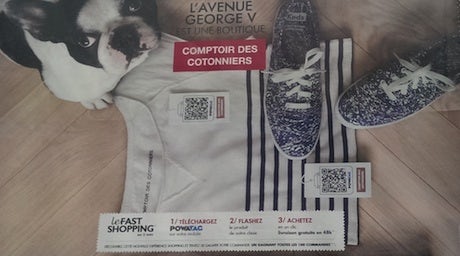Waitrose, Argos and Laura Ashley to allow shoppers to buy direct from ads
Waitrose, Argos and Laura Ashley will be among the first brands to launch mobile commerce and marketing campaigns based on start-up Powatag’s technology, which allows consumers to buy products directly from ads on TV, radio, outdoor and in print.

Laura Ashley is set to roll out its deployment in June, when it will integrate Powatag codes into its website to allow customers to make purchases by scanning product pages. It is also planning to use it within its catalogue to enable people to make purchases direct from the page.
It will be followed by brands Schuh and Universal Music in July and August respectively, with Universal Music looking at ways to make it possible for customers to order music and merchandise at gigs using their mobile phones. Argos, Waitrose and Screwfix are still considering ways to integrate the technology into their stores and catalogues, with plans to roll out later this year.
Powatag is also in talks with a number of charities including the NSPCC and the Royal British Legion, with the latter discussing the opportunity to launch a digital version of the annual Poppy Appeal that could enable people to donate via their mobiles.
Powatag is an omnichannel tech provider that aims to change how ads are delivered and customers engage with them. Its smartphone app scans codes embedded in outdoor, print, TV or radio ads to allow people to buy products. These triggers could be a QR code, a digital watermark embedded in music, radio or TV content, a signal from a Beacon or NFC device in stores or image recognition.
So far 475 brands including Adidas, Carrefour, Electrolux and BBC Worldwide have signed up to use the technology, up from the 270 Powatag touted at its launch in March. Use cases vary wildly, from Electrolux using it as a means of getting people signed up to their warranty plan to French broadcaster TF1 introducing digital watermarks into its teleshopping programming.
French fashion chain Comptoir des Cotonniers is the first brand to implement Powatag’s technology and is launching a marketing campaign across France to promote the tie-up and educate customers on how it works. The firm has already begun explaining to customers how it works in-store through staff and with a leaflet given out with purchases.
It has now rolled out 10,000 adverts across France, including 1,800 billboards in Paris and other major French cities, as well as in magazines, on café tabletops and on Uber taxis. The ads all include QR codes that allow customers to buy the products being promoted in one click using Powatag’s service.
Speaking to Marketing Week at an event in Paris to launch the campaign, Comptoir des Cotonniers’s ecommerce and CRM director Valerie Dassier said she was drawn to Powatag’s technology because it provided an “incredible way” to merge offline and online retail that was both easy and secure. She said she was also drawn to the Powatag “ecosystem”, which means that customers only have to download one app to be able to buy products from hundreds of brands.
She said the campaign is aimed at boosting impulsive purchases and driving up sales, while providing an improved customer experience. She describes Comptoir’s core audience as technologically savvy and one that will respond well to being able to buy while they wait at bus stops or have a coffee.
If the campaign meets expectations, Dassier says the brand will look to roll out further iterations, such as using Beacons for in-store marketing and in TV campaigns. It will also look to expand the campaign beyond France, including to the UK where it has 5 stores in London.







